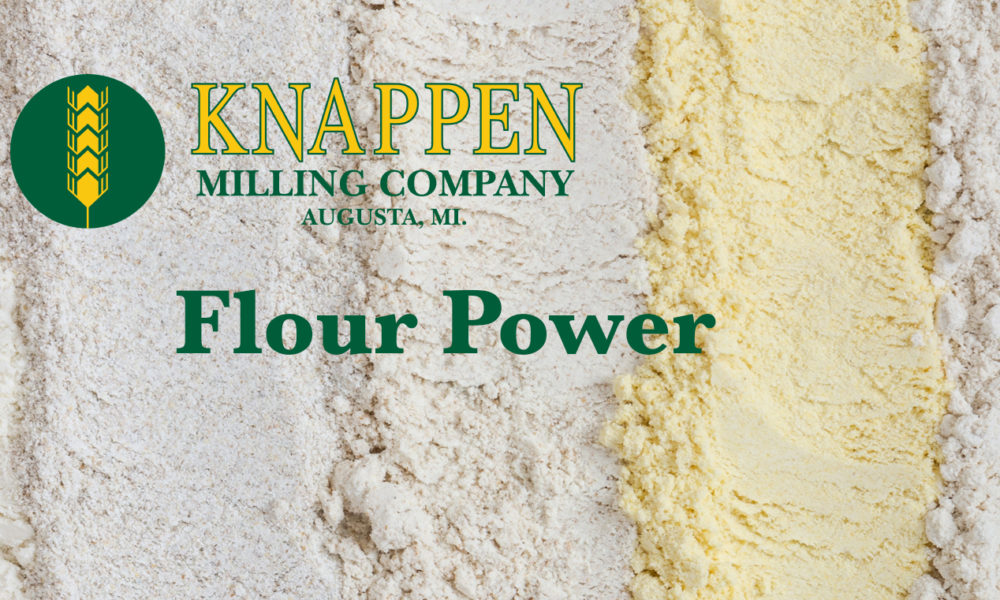
Knappen Milling Company began as a Michigan wholesale flour mill producing bran products for the growing cereal industry in Battle Creek, MI. Knappen Milling’s business has focused on the cereal, snack food, and wheat-based industries. In 2020, our Michigan wholesale flour was released to the public, in the midst of the COVID-19 pandemic as Knappen Milling Baking Flour.
Did you know there are different types of wheat flour?
Wheat Flours
Most commonly used flours are milled from wheat. Refined wheat flours are enriched with thiamin, riboflavin, niacin, and iron, and fortified with folic acid. Whole-wheat flours naturally contain B vitamins, and iron, and are a good source of fiber. Knappen Milling Co. produces and sells a variety of Michigan wholesale flour types. Our specialty being soft-wheat flour similar to cake or pastry flour. It is preferred for baked goods, cookies, pies, cakes and cereals.
Ideal for bread-making, flour from hard wheat is higher in protein, including gluten, which makes the dough sticky. Flours made from soft wheat have less protein and less elastic quality, making them better for delicate pastries and cakes.
- All-purpose flour: A refined blend of high-gluten wheat and low-gluten soft wheat. Used for baking, thickening, and breading. It’s usually sold pre-sifted.
- 100% whole-wheat flour: Produced from hulled red wheat grain. It’s commonly used in place of all-purpose flour, but it provides more fiber and other nutrients. This type of flour makes for heavier bread, it can be mixed with all-purpose flour for a lighter texture and better rising. Be careful though, its shelf-life is shorter than all-purpose flour.
- White whole-wheat flour: Made from hulled white spring wheat, it’s used instead of regular whole-wheat flour in baked goods, for a milder taste.
- Self-rising flour: It’s just all-purpose flour with salt and baking soda added. It’s usually not used for yeast bread.
- Cake or pastry flour: A fine-textured refined flour made from soft wheat. It’s high in starch and best used in cakes or pastries.
- Bread flour: Specifically used for bread-making, this refined flour is made from hard wheat and a small amount of barley flour.
- Gluten flour: A refined flour made from hard wheat, with most of the starch removed. This causes the flour to have significantly higher gluten content, increasing the strength and rising power of the dough.
- Semolina flour: A coarsely-milled, refined hard durum wheat flour. It’s commonly used in pasta, gnocchi, and puddings. And yes, it’s high in gluten.
- Flour is most commonly milled from wheat. But—it is possible to use other sources to make flour.
Non-Wheat Flours
Non-Wheat Flours usually consist of gluten-free mixes of other grains or plant sources. On their own, non-wheat flours also offer a variety of uses and qualities when baking.
- Almond meal/flour: Low in carbs and high in protein, almond flour adds moisture and a nutty taste to baked goods. It’s not meant to replace flour in yeast or quick bread.
- Amaranth flour: It has a high level of complete protein, including lysine. It’s very useful when thickening sauces, gravies, and soups.
- Barley flour: Another good soup thickener, barley flour is a way to add fiber to your baked foods as well. It contains some gluten, but not enough for adequate rising.
- Buckwheat flour: This type of flour can be added to other flours to add a touch of grassy flavor and color to your bread. Whole buckwheat has a stronger flavor and more nutrients, while white buckwheat is milder and has fewer nutrients. It’s good for pasta and pancakes.
- Corn flour: Commonly used in breading or blended with other flours for batters or dough. Cornmeal can be ground into cornflour in a food processor.
- Flaxseed meal/flour: It’s made by milling whole flaxseeds. When used in baking, it’s a good substitute for fat or eggs.
- Oat flour: Used as a replacement for flour in a variety of recipes, this flour adds a rich, nutty flavor and a more dense texture. If you use it in baked foods that need to rise, it must be combined with other flours first to make it work.
- Peanut flour: Crushed, fully or partly defatted peanuts are used in this flour. A ¼ cup of peanut flour contains eight grams of protein. It’s commonly used to thicken soups and sauces, and to add flavor.
- Potato flour: Made from either whole or dried potatoes, a ¼ cup contains 2.5 grams of fiber and 400 mg of potassium. It can be used to thicken sauces, or it can be used to add starch to baking doughs.
- Rice flour, brown: It can be used like white flour, but it gives a grittier texture in baked goods and a nutty flavor. Made from unpolished brown rice.
- Rice flour, white: It’s used for pie crusts and cookies, made from white rice.
- Rye flour: It contains less gluten than all-purpose or whole wheat flour, and produces a heavy, dense bread. If you want it to rise better, blend it with a higher protein flour.
- Soy flour: Another gluten-free flour, it’s high in protein but low in carbs. It’s a good source of calcium and an excellent source of iron and magnesium. It can be used to thicken sauces, or as a wheat flour substitute.
Knappen Milling company offers a variety of wholesale flour types depending on the season. Please contact us if there is a specific type of flour you are seeking. We also do our best to keep this list updated as a guide.

Just came upon your website as I was looking for flour that is milled in Michigan and available in retail sales. I love baking bread and trying new recipes. Will try some you have shared and hopefully your flour will be available in mid-Michigan in the near future. I am by Bay City.